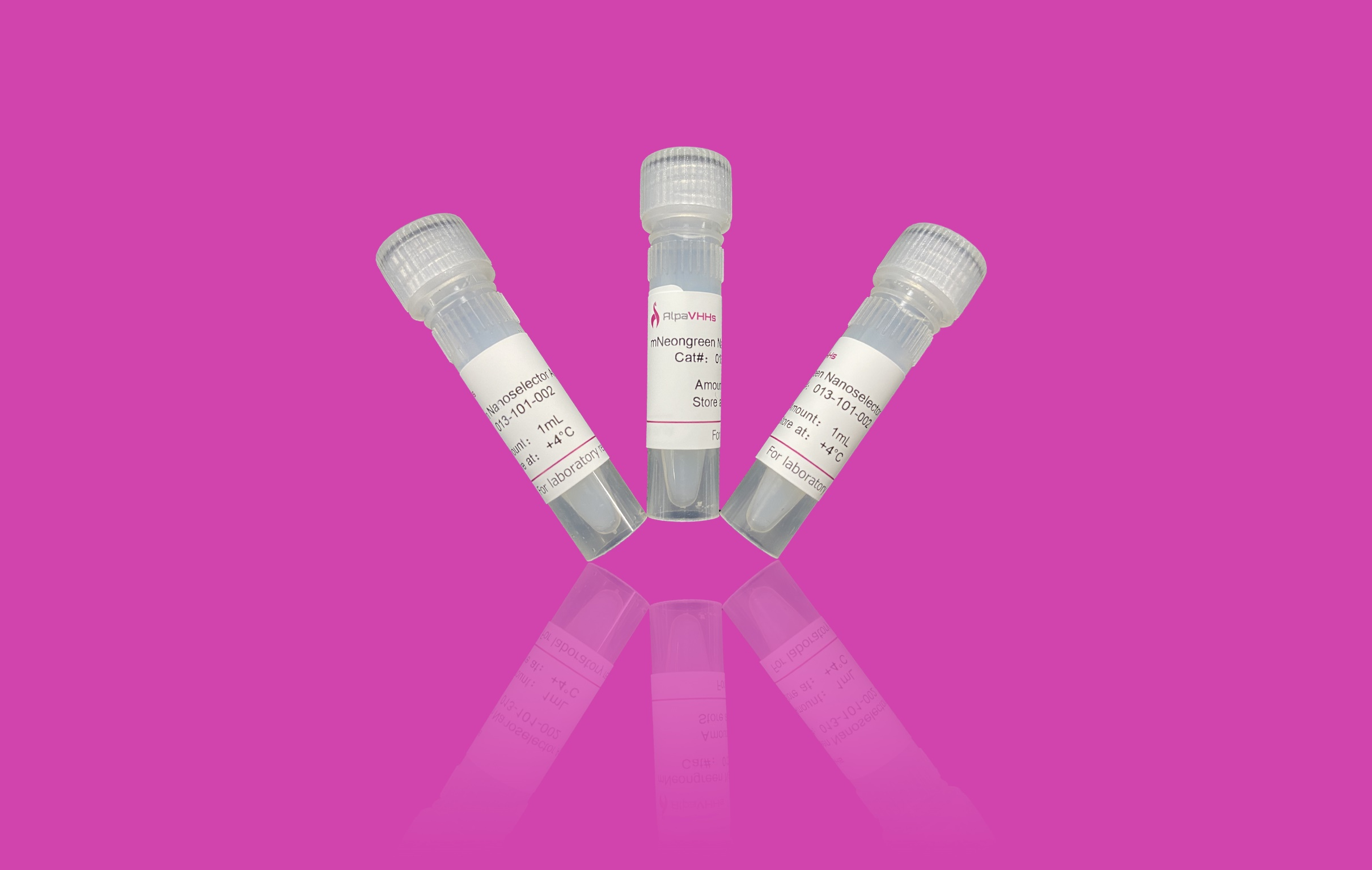· Consistent and reproducible results
· No heavy & light antibody chains
· Extraordinary binding, even under harsh conditions
· High affinity
· Short Incubation (5-30 min)
Description:
mNeogreen Nanoselector Agarose have been specifically designed to bind mNeogreen-fusion proteins. mNeogreen Nanoselector Agarose is based on small high-affinity recombinant alpaca antibody fragments covalently coupled to the surface of Agarose. mNeogreen Nanoselector Agarose is an ideal tool to isolate or purify mNeogreen-fusion proteins fast and efficiently.
Ligand: Anti-mNeogreen single domain antibody fragment (VHH, Nanobody)
Bead size: ~ 40µm
Reactivity: Recognizes mNeogreen or mNeogreen fusion protein.
Binding capacity: High binding capacity, 10 µL slurry bind about 20 µg of recombinant mNeogreen.
Storage: Shipped at ambient temperature. Upon receipt store at 4°C. Stable for 1 year. Do not freeze.
Storage Buffer: 50 % slurry in PBS containing 20 % Ethanol
Background:
mNeogreen is the brightest monomeric green or yellow fluorescent protein yet described to our knowledge, performs exceptionally well as a fusion tag for traditional imaging as well as stochastic single molecule super-resolution imaging and is an excellent fluorescence resonance energy transfer(FRET) acceptor for the newest cyan fluorescent proteins. With the mNeogreen Nanoselector, specific for this non-GFP variant, yields of fusion proteins purification are high and free from heavy and light-chain contaminants, all in under 30 minutes. Save time, save effort and get cleaner results.
Immunoprecipitation (IP)/Co-IP
Mass spectrometry (MS)
Enzyme activity measurements
Immunoprecipitation protocol
Mammalian cell lysis
Note: Harvesting of cells and cell lysis should be performed with ice-cold buffers. We strongly recommend to add protease inhibitors to the Lysis buffer to prevent degradation of your target protein and its binding partners.
For one immunoprecipitation reaction, we recommend using ~106- 107 cells.
1. Choice of lysis buffer:
* For cytoplasmic proteins, resuspend the cell pellet in 200 µL ice-cold Lysis buffer by pipetting up and down. Supplement Lysis buffer with protease inhibitor cocktail and 1 mM PMSF (not included).
* For nuclear/chromatin proteins, resuspend cell pellet in 200 µL ice-cold RIPA buffer supplemented with DNaseI (f.c. 75-150 Kunitz U/mL), MgCl2 (f.c. 2.5 mM), protease inhibitor cocktail and PMSF(f.c. 1 mM)(not included)
2. Place the tube on ice for 30 min and extensively pipette the suspension every 10 min.
3. Centrifuge cell lysate at 17,000x g for 10 min at +4°C. Transfer cleared lysate (supernatant) to a pre cooled tube and add 300 µL Dilution buffer supplemented with 1 mM PMSF and protease inhibitor cocktail (not included). If required, save 50 µL of diluted lysate for further analysis (input fraction).
Bead equilibration
1. Resuspend the beads by gently pipetting up and down or by inverting the tube. Do not vortex the beads!
2. Transfer 25 µL of bead slurry into a 1.5 mL reaction tube.
3. Add 500 µL ice-cold Dilution buffer.
4. Sediment the beads by centrifugation at 2,500x g for 5 min at +4°C.
5. Discard the supernatant.
Protein binding
1. Add diluted lysate to the equilibrated beads.
2. Rotate end-over-end for 1 hour at +4°C.
Washing
1. Sediment the beads by centrifugation at 2,500x g for 5 min at +4°C.
2. If required, save 50 µL of supernatant for further analysis(flow-through/non-bound fraction).
3. Discard remaining supernatant.
4. Resuspend beads in 500 µL Wash buffer.
5. Sediment the beads by centrifugation at 2,500x g for 5 min at +4°C. Discard the remaining supernatant.
6. Repeat this step at least twice.
7. During the last washing step, transfer the beads to a new tube.
Optional: To increase stringency of the Wash buffer, test various salt concentrations e.g. 150 mM - 500 mM,and/or add a non-ionic detergent e.g. Triton™ X-100.
Elution with 2x SDS-sample buffer
1. Remove the remaining supernatant.
2. Resuspend beads in 80 µL 2x SDS-sample buffer.
3. Boil beads for 5 min at +95°C to dissociate immunocomplexes from beads.
4. Sediment the beads by centrifugation at 2,500x g for 2 min at +4°C.
5. Analyze the supernatant in SDS-PAGE.
Elution with Glycine-elution buffer
1. Remove the remaining supernatant.
2. Add 50–100 µL Glycine-elution buffer and constantly pipette up and down for 30 - 60 sec at +4°C.
3. Sediment the beads by centrifugation at 2,500x g for 5 min at +4°C.
4. Transfer the supernatant to a new tube.
5. Immediately neutralize the eluate fraction with Neutralization buffer.
6. Repeat this step at least once to increase elution efficiency .



